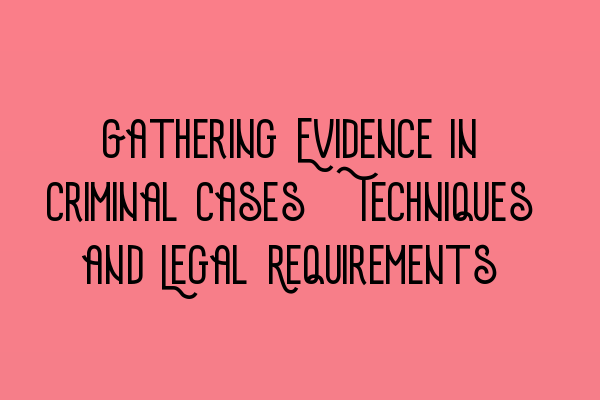Gathering Evidence in Criminal Cases: Techniques and Legal Requirements
Introduction
When it comes to criminal cases, gathering sufficient and admissible evidence is crucial in ensuring a fair trial and reaching a just verdict. In this article, we will explore various techniques used in gathering evidence, as well as the legal requirements that must be met for such evidence to be admissible in court.
Types of Evidence
The types of evidence that may be gathered in criminal cases can vary greatly depending on the nature of the crime and the available resources. Some common types of evidence include:
- Physical evidence, such as fingerprints, DNA samples, weapons, or stolen property.
- Testimonial evidence, which includes statements made by witnesses or suspects.
- Documentary evidence, such as contracts, financial records, or surveillance footage.
- Expert evidence, provided by professionals with specialized knowledge to assist in understanding complex matters.
Gathering Techniques
Law enforcement agencies and legal professionals employ various techniques to gather evidence in criminal cases. These techniques include:
- Crime scene investigation, where forensic experts examine the scene, collect physical evidence, and document their findings.
- Witness interviews, conducted by trained investigators to gather testimonial evidence and obtain statements from individuals who may have witnessed the crime.
- Surveillance and monitoring, which may involve the use of cameras, wiretaps, or undercover agents to obtain evidence of criminal activities.
- Search and seizure, where authorized individuals search specific locations or individuals for evidence related to the crime.
- Expert analysis, where specialists examine and interpret physical or documentary evidence to provide expert opinions in court.
Legal Requirements for Admissibility
For evidence to be admissible in court, certain legal requirements must be met. These requirements aim to ensure the reliability and fairness of the evidence presented. Some common legal requirements for evidence admissibility include:
- Relevance: The evidence must be directly related to the facts of the case and have probative value.
- Reliability: The evidence should be reliable and trustworthy, obtained in a way that is not tainted or compromised.
- Authenticity: The evidence must be proven to be genuine and not tampered with or fabricated.
- Hearsay rule: Hearsay evidence, which is an out-of-court statement offered for the truth of the matter asserted, is generally inadmissible unless it falls within an exception.
- Privilege: Certain communications, such as those protected by attorney-client privilege or doctor-patient confidentiality, may be privileged and not admissible in court.
Conclusion
Gathering evidence in criminal cases is a complex and meticulous process that requires adherence to legal requirements and the use of various techniques. By ensuring that the evidence gathered is reliable, relevant, and admissible, legal professionals can contribute to a fair trial and the administration of justice.
For more information on related topics, you may be interested in the following articles:
- SQE Exam Prep: Essential Study Materials for Aspiring Solicitors
- Demystifying the Solicitors Qualifying Examination Format
- LLC Formation Made Simple: Step-by-Step Guide for UK Entrepreneurs
- LLC Formation: A Step-by-Step Guide for UK Entrepreneurs
- Business Regulations in the UK: A Comprehensive Overview
